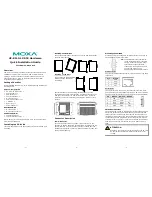
CAUTION INSTRUCTIONS FOR L&L KILNS
cautions.pdf
REV: 11/1/2016
Page 7
2016
L&L Kiln Mfg, Inc. 505 Sharptown Rd, Swedesboro NJ 08085 P:856.294.0077 F:856.294.0070 [email protected] hotkilns.com
TRIPPING HAZARDS
1. Be sure to remove tripping hazards near the kiln.
2. In particular be sure to keep the kiln cord out of traffic
areas.
CLOTHING TO AVOID
1. When working around a hot kiln be careful of the kinds of
clothes you are wearing.
2. Some clothes could potentially catch on fire if they touch
the hot surface of a kiln.
3. Also avoid loose fitting clothes that could catch on the
kiln.
PREFIRING CAUTIONS
KILN WASH CONTAINS SILICA
1. Long term exposure to silica dust could cause lung
damage.
2. See the MSDS sheets in your instruction manual or here:
hotkilns.com/msds.
3. Exercise proper caution when mixing the dry powder and
when removing it from your shelves.
4. Use a NIOSH approved particulate respirator for dust and
use proper ventilation. You can buy these from safety supply
houses. (NIOSH_approval #TC-21C-132 is an example).
DO NOT USE SILICA SAND
1. Do not use silica sand in the kiln.
2. Some people like to use this as a work support medium.
3. The silica sand will attack the elements and thermocouples.
4. It can migrate in the kiln from expansion and movement
due to heat.
5. If you must use sand to support or stabilize your load try
alumina oxide or zirconia oxide sand.
NEVER FIRE MOIST GREENWARE
1. Never load moist greenware or pots in your kiln.
2. The expanding water vapor in the ware could cause the
ware to explode, damaging your kiln interior.
3. We recommend using a dry out segment in your bisque
program at 66°C (150°F). (Note that, because of the
thermocouple offset programmed into our DynaTrol when we
use the ceramic protection tubes, the display temperature
will read 93°C (200°F) when the real temperature is 66°C
(150°F)).
4. Remember that there may be water trapped in the work
even if you can’t always see it. If you place a piece of
greenware next to your wrist and it feels cool to the touch it
probably has too much moisture in it to fire.
CAUTION WITH USE OF WAX
1. When you heat wax (in wax resist and lost wax
processes) it will volatilize and potentially condense in the
cooler ventilation ducts.
2. Over time this can cause a fire hazard because the wax
is flammable.
3. Depending on how the vent motor is mounted, the wax
can also gum up the vent motor.
4. If you use these processes it is entirely up to you to
engineer and monitor the safety of the installation.
5. The use of wax will void the warranty of the vent system.
DO NOT FIRE TEMPERED GLASS
1. Tempered glass can explode when fired.
STORE SHELVES IN A DRY LOCATION
1. Shelves can absorb moisture.
2. This can cause them to explode when fired. (This is
especially true of nitride bonded silicon carbide shelves).
DO NOT USE CRACKED SHELVES
1. Cracked shelves can fail in the middle of a firing causing
the whole load in your kiln to collapse.
DO NOT FIRE TOXIC, FLAMMABLE, OR
UNKNOWN MATERIALS









































